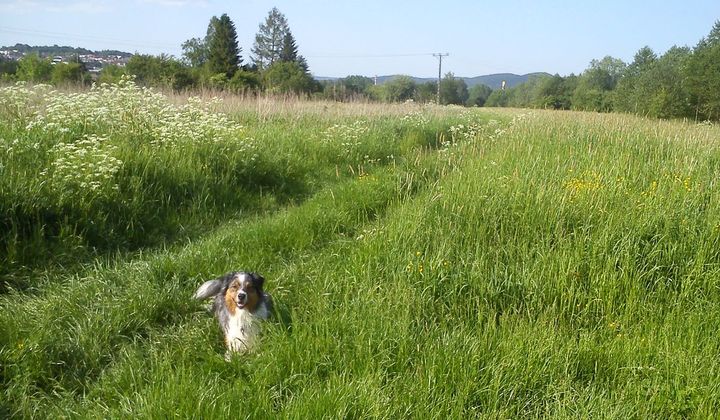Vegan contribution to dog and wolf diet speculated
Voyageurs Wolf Project again delivered evidences about another rare behavior, discovering not only local gray wolf individuals eating berries purposefully, but also regurgitating them to their pups. The basic question is to WHY those wolves eat fruits.
Wolf sympathy for certain kind of fruits is frequently anecdotal.
Wolves are obligate carnivores, so we fill their watermelons with treats they do like. Either way, the watermelon is enriching because it provides the wolves an opportunity to utilize their instinctive behaviors. [..] This behavior is known as dissection and we give our wolves the opportunity for this behavior with feeding carcasses, enrichment boxes, and other sources such as watermelons.
— Wolf Park interns staff once explained the point via instagram.
Voyageurs Wolf Project again delivered evidences about another rare behavior, discovering not only Minnesota gray wolf individuals eating berries purposefully, but also regurgitating them to their pups (rendezvous point, nearby a den).
It left me with some questions. - How important food are forest fruits for wolves? Is it a local population's adaptation to conditions offered by an ecological niche? Or maybe evolutionary adapted biological changes, distinguished for modern gray wolf species? - Regurgitated berries' leftovers, found by researchers afterwards, weren't completely digested (and completely eaten), they were partially chewed.

According to respectable scientific sources, the gray wolf remains a typical predatory animal with complete predatory sequence being used in hunt, where its diet was defined as obligate carnivore - like feline, including domestic cats - they need their diet being strictly based on meat, without the physical ability to digest herbivore-oriented nourishment. However, VWP discovery could possibly point on the facultative carnivore - canine like domestic dog - option, if the answer to WHY wolves eat fruits, would be scientifically clear.
Sticking to Coppinger's theory, primal dog (self)domestication process caused pre-dogs to give up their predation and hunting habits for scavenging, making them become the first predatory species put through the human-focused domestication process.
It is however not clear whether this change was associated with the initial domestication, or represents a secondary shift related to the subsequent development of agriculture.
— study reports, researching DNA samples of 392 dogs (incl. 95 regional types, 19 native Greenland ones, 25 Australian Dingoes and 126 multiple breeds allover the world) in comparison to selected wild canids (5 golden jackals, 1 coyote, 51 wolves in wildlife and 15 sanctuary ones).
Other scientists previously confirmed the adaptation to starch-rich food based diet itself, comparing the dog genome to the wolf one in detail, where differences (36 genetic regions) were categorised, inter alia, into
- genes (19) responsible for behavior traits (brain functions, nervous system development pathways)
- genes (10) responsible for starch digestion and metabolism of carbohydrates
and 3 additional dog genes (AMY2B, MGAM, SGLT1) exclusively, which appeared responsible for glucose reuptake.
So, habitat established by humans who changed their way of life from nomadic (hunter-gatherer) into settled (agriculture, then animal husbandry), made dogs evolve to be more omnivore than carnivore.[1] Their digestive system (gastrointestinal tract, intestines) is currently longer and more weighty than it is in case of wolf - pack hunting, demanding them to consume instantly.
Obviously, hard to imagine any forest animal's diet containing a vegetable or strachy fruit, planted by human in principle. Anyway, feasting wolves eagerly start consuming a preyed animal's carcass from its internal organs regularly containing the rest of half-digested plants (herbivore-oriented diet).[2]
Organ meat is the first to be eaten. Except in rare cases, all significant pieces of muscles are eaten. Ribs are typically eaten, bones are often partially consumed, and nearly all the hide is commonly eaten. Even the muscles that make up the lining of the stomach are eaten.[3]
Wolf natural diet consists approximately 90% meat (protein), sometimes switching to fruits like documented berries, which deliver a bit of minor portions of carbs (likely just a water).
To survive (consume, avoid a danger, reproduce) does not mean to thrive (health, animal welfare, strong/attractive partnership/company). Modern dogs (free-ranging scavengers or companion animals) are able to thrive on a diet rich in plants, whereas wolves (typical apex predatory) hypothetically can survive on it, but they obligatory require a high-meat diet to thrive.
Even if gray wolf and domestic dog both split up from a common ancient wolf ancestor.
References:
Diet adaptation in dog reflects spread of prehistoric agriculture (2016); study by group work
The genomic signature of dog domestication reveals adaptation to a starch-rich diet (2013); study by group work
Coppinger Raymond, Lorna; „Dogs. A Startling New Understanding of Canine Origin, Behavior, and Evolution” (2002), "What is a dog?" (2015), "How Dogs Work" (2016)
[1] Being precise, domestic dog adapted its digestive system to absorb proteins (amino acids) coming from legumes. The rest is evolutionary adaptable absorption of carbohydrates - from grain plants, starchy root vegetables and starchy fruit - in digestible form (energy value).
[2] Hard starch (vide hay or straw) is not digestible to whichever mammal, but supports omnivorous digestion process as an indigestible fiber (cellulose), then being excreted (final section stage).
[3] citation after Moose & Wolves if Isle Royale project

